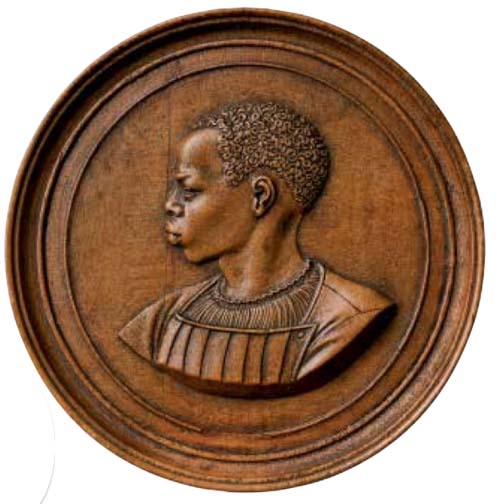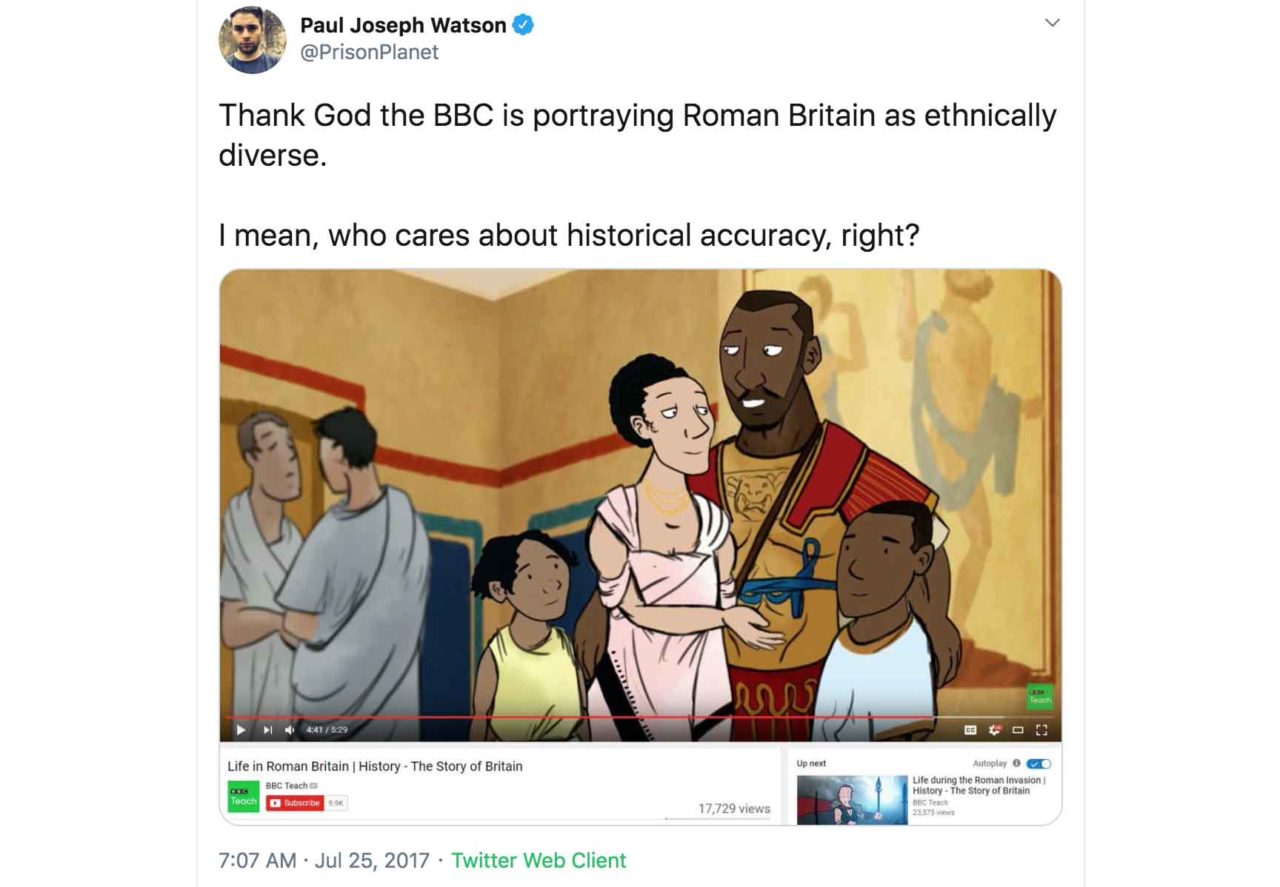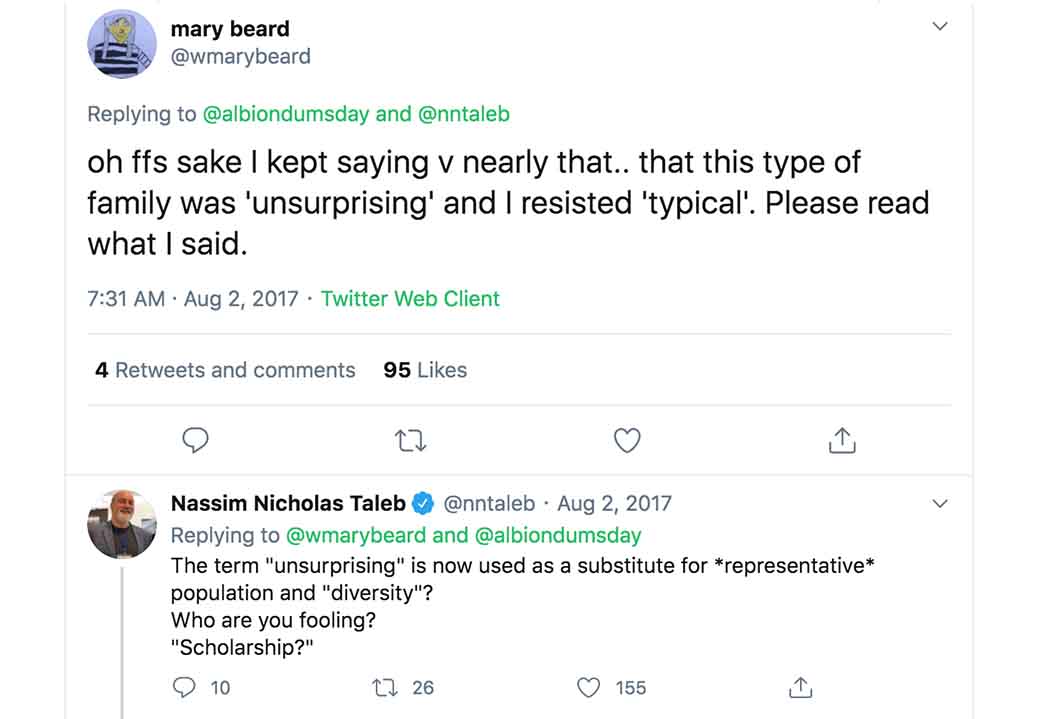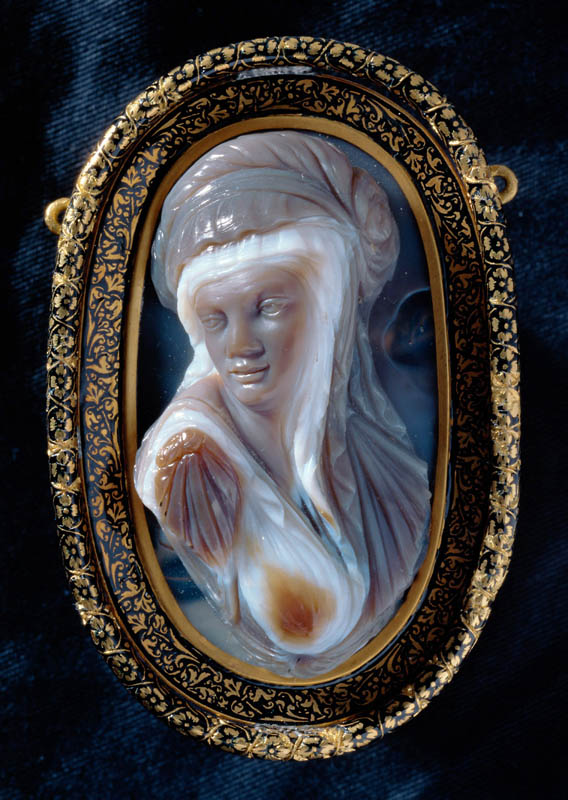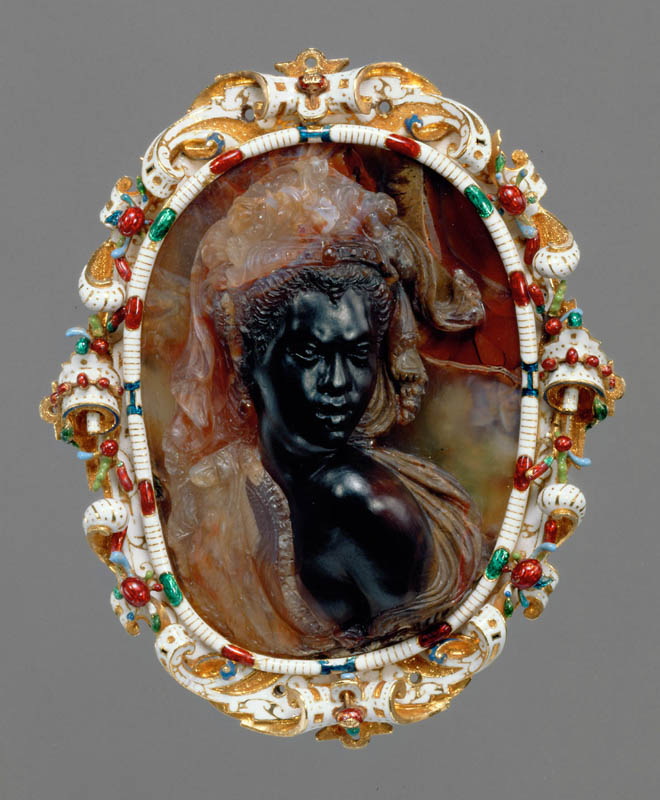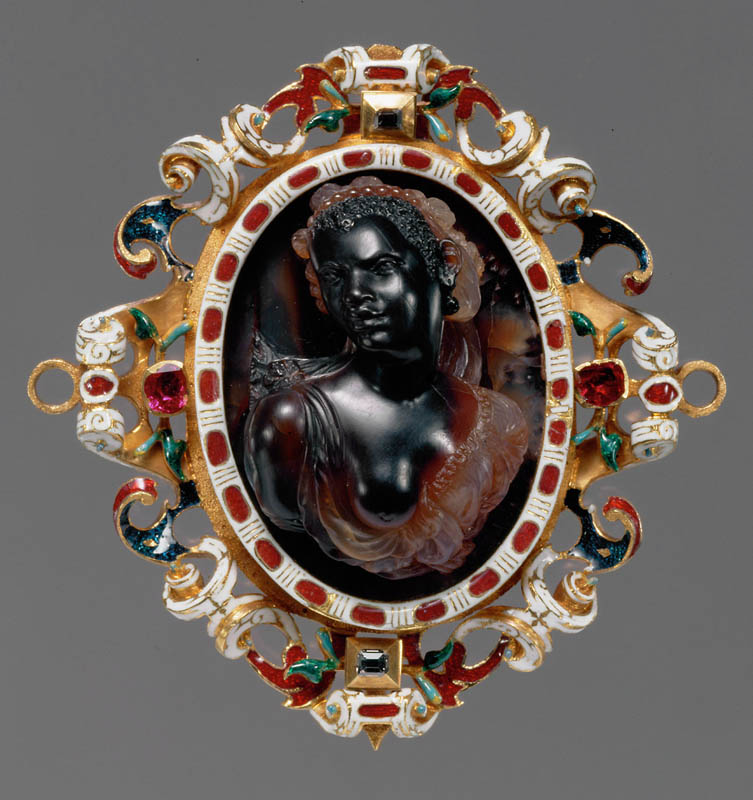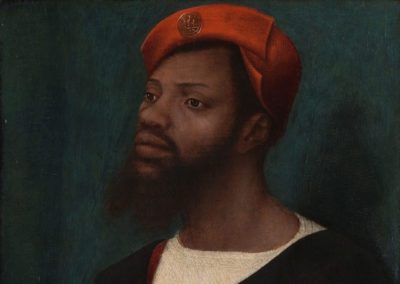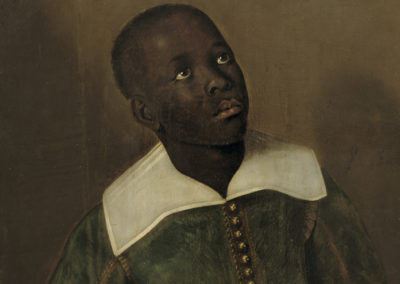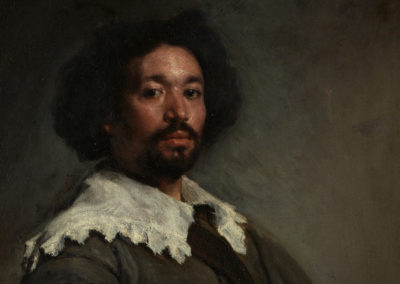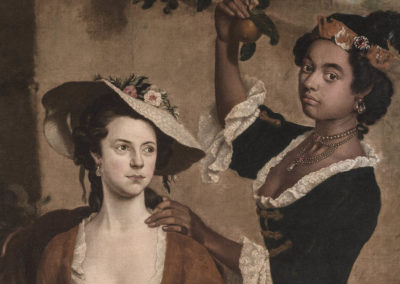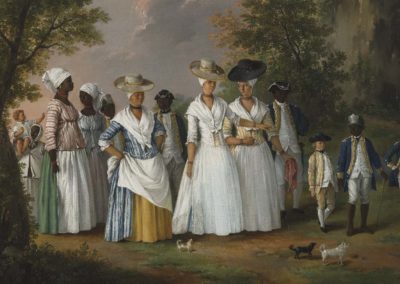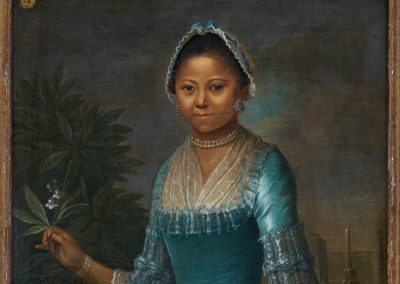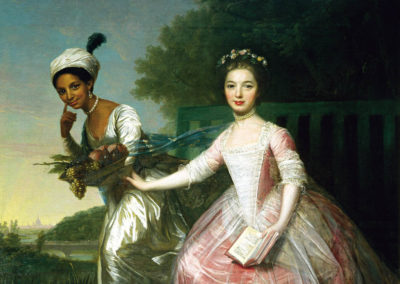Harlie Des Roches, a historical costumer and living historian, lays out some necessary historical truths about the Black presence in Europe and her own experience in living history.
When [Fashion History Timeline editor] Dr. De Young first approached me (Fig. 1) about writing this, I was immediately flattered – and then petrified. I had been slated to give a forty-five-minute talk on the African presence in Renaissance Europe as a part of a larger conference called “Fashioned in History” hosted by the Jamestown-Yorktown Foundation. The event was postponed because of the COVID-19 pandemic and I had stopped working on the presentation since I didn’t have a deadline. My words to her were:
“Just so you know, I’m not an academic person. I’m a regular person who’s passionate about trying to dispel the myth that Europe was a white utopia that never had Black people until the days of slavery and that we were all slaves.”
I’m writing this essay to a very specific audience: other Black nerds like me who’ve been told we don’t belong. It would be great if other people reading learned a thing or two and checked their assumptions at the door. I was recently introduced to a young Black person who’s interested in living history. In our early conversations, she said this to me:
“That’s like the main reason I really didn’t look into history stuff or join any groups. I encountered quite a few that basically said that my people just weren’t there so ‘it wouldn’t be 100% accurate.’ It was pretty discouraging TBH.”

Fig. 1 - Harlie Des Roches (American). My happily un-enslaved self in persona, 2019. Source: Courtesy of the author
Fig. 2 - Artist unknown (Netherlandish). The King's Fountain, Lisbon, ca. 1570-80. Lisbon: The Berardo Collection. Source: Wikimedia Commons
That level of ignorance and discouragement is exactly what I’m here to address. Twenty-two years ago, I didn’t have a good comeback. I knew that Black people had been in Britain from the days of Rome, but being able to readily prove it with solid sources is different (Fig. 2). These yoots don’t know how good they got it. Google makes it much easier for people to find this information. The thing is, most people don’t go looking because they already know…
“There were no Black people in sixteenth-century England.”
How many times have I heard some version of this falsehood? These people usually go on to tell me that “the history of Black people in England starts with the Trans-Atlantic trade of enslaved people. You’re trying to be politically correct.” Too many white people have no issues telling me that they’re tired of “real” history being tampered with because of modern sensibilities, like I’m the one doing something wrong. People are uncomfortable with the truth because they believe the whitewashed version that they’ve been taught in school and consume in popular media. Game of Thrones, anyone? The only Black people in that entire series are enslaved and the men are eunuchs. The TV-watching public accepts this garbage as a reflection of history, despite the liberal additions of magic and dragons.
Even many Black people that I’ve encountered don’t understand why I choose to study the history of Tudor England. They say:
“You’d’ve just been a slave anyway.”
Ironically, slavery – aside from the practice of villeinage, which would’ve never applied to Africans anyway – was not legal in England in the 16th century. Any African, even if enslaved elsewhere, would’ve become free upon setting foot on English soil. That is not to say that an African living in England had an easy time, but the assertion that I would have been enslaved had I lived then is patently false (Fig. 3).
Not-so-funny story: when I was driving home from the Ren Faire one summer, these truckers saw me dressed up in my garb and asked me if I was being held against my will. I didn’t get what they meant at first. They saw my sixteenth-century working clothing (Fig. 4) and concluded that I was dressed as nineteenth-century enslaved woman. I was livid and embarrassed. (The nerd in me was like, “you idiots are off by 300 years on the clothing!”) But to people not into history, the minute you put on a linen apron and cap, it’s all the same. The Black woman in me fumed that they decided that I was dressed like a slave. I specifically don’t go later than the sixteenth century because I very much never want to be perceived as portraying an enslaved person. Why is “slave” the only option for me? To only ever be seen as property?
Why bother, you ask? Well, it matters to me that Black people understand that we were there, even if white people don’t. It matters to me that a Black person can hold their own in a conversation with ignorant people and spit back facts. It matters to me because these assertions and viewpoints are based on a racist, white-washed Hollywood version of Europe as a white utopia being ruined by people of African descent rather than acknowledgement of the indisputable truth (Fig. 5):
Yes, we were there. We’ve been here all along.
Fig. 3 - Friedrich Hagenauer (German, 1499-1546). Bust of a Young Black Man, ca. 1530. Carved maple wood. Munich: Staatliche Münzsammlung. Source: Revealing the African Presence in Renaissance Europe, p. 86
Fig. 4 - Albrecht Durer (German, 1471-1528). Study of Katharina, 1521. Silverpoint drawing on paper; 20 x 14 cm (7.8 x 5.5 in). Florence: Galleria degli Uffizi. Source: Wikimedia Commons
Fig. 5 - Jan Jansz Mostaert (Dutch, ca. 1474?– 1552). Portrait of a Black Man, ca. 1520–25. Oil on panel; 30 × 20.3 cm. Amsterdam: Rijksmuseum, SK-A-4986. Source: Rijksmuseum
So where does this persistent belief of an all-white Tudor England (1485-1603) stem from? Bad history. Bad anthropology. Popular media. When the BBC posted a cartoon short of Roman England (Britannia) to YouTube, one of the high-ranking soldiers was depicted as a Black man. White people on the internet lost their collective minds (Fig. 6).
The amount of hate generated by that choice shows how much racism permeates our collective discourse. My least favorite part of that dialogue was a Twitter battle (Fig. 7) between mathematical statistician Nassim Nicholas Taleb, who was fanning the flames of bigotry and ignorance to line his pockets, and renowned classicist Mary Beard, who is Professor of Classics at Cambridge University.
Fig. 6 - Paul Watson (British). "Thank God the BBC is portraying Roman Britain as ethnically diverse. I mean, who cares about historical accuracy, right?", Jul 25, 2017. Tweet. Source: Twitter
Fig. 7 - Mary Beard & Nassim Taleb. "oh ffs sake I kept saying v nearly that...", Aug 2, 2017. Tweet. Source: Twitter
Taleb was heavily invested in proving that brown-skinned Africans were not present in Roman Britain, which led to increased book sales after his Twitter battle. Whether or not he believed it is immaterial; enough people do believe it for him to line his pockets with racist money. And at the end of the day, Black people still face the repercussions of the perpetuation of this myth.
These same people never question the accuracy of the ethnicity of the white actors in a film or TV show. Brad Pitt has Scottish, Irish, and English heritage, yet he portrayed Achilles, a Greek demigod, in the film Troy (2004) with nary a cross word uttered. Yes, it’s a myth – but these people lost their minds when Achilles was portrayed by a Black actor in the BBC production Troy: Fall of a City (2018) (Ling).
Yes, we were there.
Fig. 8 - Lucas Cranach the Elder and Workshop (German, 1472–1553). St. Maurice, ca. 1520-25. Oil on linden; 137.2 x 39.4 cm (54 x 15 1/2 in). New York: Metropolitan Museum of Art, 2006.469. Bequest of Eva F. Kollsman, 2005. Source: Metropolitan Museum of Art
Many white people complain about the revisionist, liberal ‘blackwashing’ of history any time we assert the truth about the contributions of Black people throughout history. The reality is that the racist whitewashing of history has been par for the course. It’s estimated that Black men accounted for about 25% of cowboys working in the United States in the 19th century and yet, until very recently, there haven’t been many depictions of Black cowboys in Hollywood (Nodjimbadem). Hollywood’s most famous cowboy, the Lone Ranger, is speculated to have been based on Black cowboy Bass Reeves – where is his movie (Morgan)??
The average US resident might scoff at the idea that Black people would even know how to ride horses, let alone that they could be cowboys. During a recent protest against police brutality in Chicago, a Black horseman rode through the streets of Downtown and was accused of stealing a police horse (Evans). The concept that a Black man owned a horse and rode well was something that they had to explain away. The vitriol lobbed at the horseman, Mr. Hollingsworth, rose to threats of violence and his car was eventually vandalized. Black people are pigeonholed, then denigrated. It’s beyond exhausting.
Think of all the popular movies, TV shows, and books that are set in Renaissance England. Now think about how often Black people are depicted at all, let alone given speaking lines or a major role. If you do find us there, it’s usually in the context of us being enslaved by wealthy English landowners.
When I started participating in living history events over 22 years ago, my then-partner (who is white) assumed that I would adopt an African persona. He was very excited by the prospect, but I was not interested in doing an African impression. I wanted to wear Elizabethan clothing (Fig. 8). I settled on Scotland because his persona was a half Scot/half Frenchman and I could share that with him and still have my pretty English clothes. Despite my insistence that I wanted to be a European, he kept asking and asking. I finally had to blow up at him to get him off my case. I think it was more for him than it was for me. So he could show me off as something exotic. I’m not quite sure what his deal was, but I’m definitely still angry about it. Frankly, a Black woman as a courtier to Queen Elizabeth I is much more plausible than the convoluted stories that white re-enactors concoct to explain why their costume bits and names don’t match (like a backstory about a merchant father who traveled all over the world and apparently through time, or a mother who was kidnapped by pirates yet her life was spared and she lived happily ever after as a captain’s wife. Give me a break).
Why is there such resistance to acknowledging our existence? I could spend hours unpacking that question, but the answer is summarized easily in one word: racism. To acknowledge our existence and contributions is to question white people’s sense of self and achievement. Black people in the United States had our culture taken from us and replaced with the mythos of the inferior enslaved person. So when I show up at a living history event, not as a slave or a servant, but as someone wearing markers of rank, in nice clothing, it is much easier to dismiss me as a product of “political correctness” than to acknowledge that the person whose life I’m recreating might have actually existed (Fig. 9). So how do we know there were Black people in Tudor and Jacobean England? The same way that we know that there were any people in Tudor and Jacobean England: HISTORIANS! The lives of average people are generally not recorded for posterity because they aren’t of interest to enough people to bother; there are so many church records and contemporary references to Africans in England that our existence during that time cannot be denied (Fig. 10).
Yes, we were there.
It is eight (8) miles from Spain to Morocco at the nearest point (across the Strait of Gibraltar), but it’s nearly 900 miles from Warsaw to London (Fig. 11). Which trip is more likely to have occurred with regularity? While this post is focused on England, Black people certainly were a vibrant part of Spanish and Italian societies as well. So if you’re willing to accept that Spanish and Italian people visited England (clearly not in dispute), then you have to accept that we were there too. Whether or not Africans were a part of English society in the sixteenth century is not a matter of speculation or debate. We are not begging to be included so that we feel better about ourselves. We are demanding that our presence (Figs. 12-14) and contributions be acknowledged.
Yes, we were there.
Fig. 9 - Artist unknown (Flemish or German). Portrait of a Wealthy African, ca. 1530–40. Oil on panel; diameter without frame 23.3 cm. Private collection. Source: The Baltimore Sun
Fig. 10 - After Pieter Bruegel the Elder Johannes van Doetechum & Lucas van Doetechum (Flemish, d. 1605 & before 1589). "Bruyntje Springh-in'-t- Bed" and "Flip de Duyvel", ca. 1564/1565. Etching; sheet: 18 x 26.3 cm (7 1/16 x 10 3/8 in). Washington, DC: National Gallery of Art, 1975.112.34. Andrew W. Mellon Fund. Source: NGA
Fig. 11 - Designer unknown. Map of Portugal, Spain, & Morocco, 2020. Source: Portugal.com
Fig. 12 - Workshop of Girolamo Miseroni (Italian). Cameo, around 1560. Agate (brown, white and gray); frame: gold, enamel; 6.7 x 4.3 cm. Vienna: Kunsthistorisches Museum, Antikensammlung, XII 121. Source: KHM
Fig. 13 - Workshop of Girolamo Miseroni (Italian). Cameo, 1602/08. Agate (black and reddish brown); frame: gold, enamel; 6.4 x 5.3 cm. Vienna: Kunsthistorisches Museum, Antikensammlung, XII 806. Source: KHM
Fig. 14 - Workshop of Girolamo Miseroni (Italian). Cameo, around 1610. Agate; setting: gold, enamel, 2 diamonds, 2 rubies (mentioned in 1619); 6 x 5.9 cm. Vienna: Kunsthistorisches Museum;, Antikensammlung, XII 108. Source: KHM
Fig. 15 - Artist unknown (British). Black Trumpeter at Henry VIII's Tournament, 1511. Westminster Tournament Roll. Source: Wikimedia Commons
John Blanke, The Trumpeter
Let’s start with John Blanke. He was a trumpeter in the Court of Henry VII (National Archives). It’s possible that he came with Katherine of Aragon about 1501 when she left Spain to marry Arthur (who was supposed to be king, but died). His wages of 8d per day were noted in the accounts of the Treasurer of the Chamber (Kaufmann 7). He was very much not enslaved, and not only earned a salary but successfully petitioned Henry VIII for a 100% raise. He even rated getting a wedding present from King Henry VIII in 1512, so you know he was somebody. According to Kaufmann’s book, the image in figure 15 is the only known portrait of an African in Tudor England. This lack of visual evidence no doubt feeds into the misconception that Black people weren’t present in Tudor England.
Jacques Francis, The Salvage Diver
This dude was not only on the dive team, but was the head of the dive team to bring up some of the guns from the sunken Mary Rose in 1546 (Kaufmann 32). Because of the excellent reputation the team had developed they were asked to do another job. In the course of that project, his master? Employer? Peter Corsi was accused of theft. Francis was called into court to provide testimony, and thus became the first African on record to give a deposition in an English court. This is noteworthy because enslaved people could not provide evidence in a court of law.
Mary Fillis, the Moroccan Convert
We know of Mary from her baptismal record – June 3, 1597. She worked for and possibly lived with her employer, Milicent Porter, who was a seamstress (Kaufmann 134). Mary originally came to England with her father, Fillis of Morisco, as a small child (approximately aged six) in 1583. Her fate after Porter died in 1599 remains a mystery.
Reasonable Blackman, Silk Weaver
Tell me that’s not the best name for a vendor EVER! Reasonable was a silk weaver living in Southward during the last quarter of the sixteenth century (roughly 1579-1592). Dr. Kaufmann conjectures that he came to London by way of the Netherlands, which had a good-sized African population and a thriving textile manufacturing industry (Kaufmann 113). It is known that he had at least three children, two of whom sadly perished in the London plague of 1592.
Cattelena of Almondsbury, Independent Singlewoman
I’m tempted to quote the Destiny’s Child song here, but I’ll spare you. Quite simply, Cattelena lived her life on her own terms. She was unmarried and certainly not enslaved. In fact, she owned a cow and profited by selling milk and butter to her neighbors. There is even an inventory of all the items that she owned. She lived in Almondsbury near Bristol until her death in 1625 (Kaufmann 243).
Diego, The Circumnavigator
Diego became a crew member aboard Francis Drake’s ship in Panama in 1572. He was able to broker a partnership between Drake’s crew and the Cimarrons (African settlers who had formerly been Spanish captives) to seize over 150,000 pesos of Spanish silver and gold (Kaufmann 56). Diego accompanied Drake back to Plymouth and then set sail in 1577 on the Golden Hinde to circumnavigate the globe. He eventually succumbed to battle wounds in 1579 in the Maluku Islands, then known as the Spice Islands because of the nutmeg, mace, and cloves found there.
Anne Cobbie, the Tawny Moor with Soft Skin
Anne was a sex worker in the 1620s in the St. Clement Danes parish who commanded a high price because of her looks. When it comes to cultural exchange, sex is one of the first boundaries that is typically crossed. Her name is known because the people who owned the brothel where she was employed were brought into court in 1626 (Kaufmann 219).
Fig. 16 - Jane Malcolm-Davies & Ninya Mikhaila. The Typical Tudor, 2020. Source: The Tudor Tailor
(Yes, that’s me on the cover of the newest offering of The Tudor Tailor!)
Black excellence is not new.
Yes, we were there.
Die mad about it.
This essay cannot possibly cover the depth and breadth of this topic. However, I hope that I’ve given you a bit of insight and new perspective. Check out these resources if you want to learn more…
Further Resources:
- “Black Presence: Asian and Black History in Britain, 1500-1850.” Black Presence. The National Archives. Accessed 28 August 2020. https://www.nationalarchives.gov.uk/pathways/blackhistory/index.htm
- “Black Tudors…A peek into the lives of ten people of the African Diaspora who lived in Tudor Britain.” Black History Month, 16 May 2019. Accessed 28 August 2020. https://www.blackhistorymonth.org.uk/article/section/author-and-historians/black-tudors-a-peak-into-the-lives-of-ten-people-of-the-african-diaspora-in-tudor-britain/
- Boseley, Sarah. “Mary Beard abused on Twitter over Roman Britain’s ethnic diversity.” The Guardian, 6 August 2017. Accessed 28 August 2020. https://www.theguardian.com/uk-news/2017/aug/06/mary-beard-twitter-abuse-roman-britain-ethnic-diversity
- Dwyer, Colin. “A Cartoon’s Black Star Prompts A Fight: What Did Roman Britain Look Like?” NPR. National Public Radio, 7 August 2017. Accessed 28 August 2020. https://www.npr.org/sections/thetwo-way/2017/08/07/542077027/a-cartoons-black-star-prompts-a-fight-what-did-roman-britain-look-like
- Kaufmann, Miranda. “Black Faces of Tudor England.” BBC History Magazine, November 2017. Accessed 28 August 2020. www.mirandakaufmann.com/uploads/1/2/2/5/12258270/bbchmblacktudors.pdf
- Kaufmann, Miranda. Black Tudors: The Untold Story. London, England: Oneworld Publications, 2017. http://www.worldcat.org/oclc/1083265546
- “The Missing Tudors: Black people in 16th-century England.” HistoryExtra, Immediate Media Company Limited, 27 July 2012. Accessed 28 August 2020. https://www.historyextra.com/period/tudor/the-missing-tudors-black-people-in-16th-century-england/
- Nubia, Onyeka. England’s Other Countrymen: Black Tudor Society. London: Zed Books, 2019. http://www.worldcat.org/oclc/1159881877
- Olusoga, David. “Alt History: Black British History We’re Not Taught in Schools – BBC Stories.” YouTube, 26 June 2019. Accessed 28 August 2020. https://www.youtube.com/watch?v=Ut5gtrezN4E&feature=youtu.be
- Spicer, Joaneath A., Natalie Zemon Davis, K. J. P. Lowe, and Ben Vinson. Revealing the African Presence in Renaissance Europe. Baltimore: Walters Art Museum, 2012. https://thewalters.org/wp-content/uploads/revealing-the-african-presence-in-renaissance-europe.pdf
References:
- “John Blanke, Black Trumpeter.” Black Presence, The National Archives. Accessed 28 August 2020. https://www.nationalarchives.gov.uk/pathways/blackhistory/early_times/blanke.htm
- Evans, Maxwell. “South Side Cowboy Harassed After False Social Media Posts Claim He Stole Police Horse.” Block Club Chicago, 2 Jun 2020. Accessed 28 August 2020. https://blockclubchicago.org/2020/06/02/south-side-cowboy-harassed-has-car-egged-after-false-social-media-posts-claim-he-stole-police-horse/
- Kaufmann, Miranda. Black Tudors: The Untold Story. London, England: Oneworld Publications, 2017. http://www.worldcat.org/oclc/1083265546
- Ling, Thomas. “No, the BBC is not ‘blackwashing’ Troy: Fall of a City.” RadioTimes. Immediate Media Company Ltd, 24 February 2018. Accessed 28 August 2020. https://www.radiotimes.com/news/tv/2019-02-12/troy-fall-of-a-city-blackwashing-casting-black-actors-greek-myth/
- Morgan, Thad. “Was the Real Lone Ranger a Black Man?” History.com. A&E Television Networks, LLC, 1 February 2018 https://www.history.com/news/bass-reeves-real-lone-ranger-a-black-man
- Nodjimbadem, Katie. “The Lesser-Known History of African-American Cowboys.” Smithsonian Magazine, 13 February 2017. Accessed 28 August 2020. https://www.smithsonianmag.com/history/lesser-known-history-african-american-cowboys-180962144



